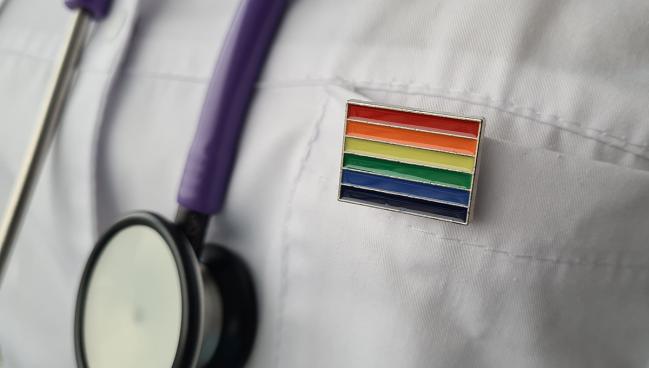Sexual Minorities See Sharpest Impact of SDOH on CV Health
These factors negatively affect not just LGBTQ+ but also heterosexual individuals, though to a lesser degree.

For sexual-minority adults, social determinants of health (SDOH) are particularly detrimental to cardiovascular health, according to US data.
The new insights come from the National Health Information Survey (NHIS), conducted by the US Centers for Disease Control and Prevention (CDC).
“As we look at the status of cardiovascular health in the United States, it behooves us to look a little bit more deeply at the fundamental underpinnings of what [factors] drive those health outcomes,” Garima Sharma, MBBS (Inova Schar Heart and Vascular, Falls Church, VA), the study’s senior author, told TCTMD.
SDOH can inform efforts to improve health at an individual and a population level, she stressed. Given that “historically, marginalized populations have had worse health,” said Sharma, it’s important to better understand why.
Led by Danish Iltaf Satti, MBBS (Johns Hopkins School of Medicine, Baltimore, MD), and Jeffrey Shi Kai Chan, MBChB, MPH (Cardiovascular Analytics Group, China–UK Collaboration, Hong Kong), the study was published in the February 11, 2025, issue of the Journal of the American College of Cardiology.
Past research has shown that sexual-minority people have a heightened risk of CVD, especially when they also belong to other minority groups. While conventional risk factors and a higher prevalence of HIV/AIDS may be contributors, they do not explain the whole risk, Satti and colleagues say. An outsized burden of SDOH is another explanation.
“For sexual-minority individuals, these SDOH may intersect with unique challenges stemming from societal stigma, discrimination, housing instability, and marginalization, leading to heightened stress levels, reduced healthcare access, and disparities in health behaviors,” the investigators write.
“Unfortunately, in these times, [sexual-minority individuals] already feel extremely disconnected,” Sharma emphasized. “They have a high burden of anxiety [and] depression. They face a lot of interpersonal-level minority stressors in their life: denial of services, microaggressions towards them, rejection from their families, rejection from the society.”
Yet there is some good news in that the most potent SDOH uncovered by this study—food insecurity and psychological distress—are “actionable,” Sharma noted. Also important: most of the participants were below age 45, a key time for CVD prevention, she added. “If we are going to make an impact on better health for all, then we cannot discount this population” that’s already sizeable and is still growing.
Worse Health, Higher Mortality
Using data from 2013 to 2017, the researchers identified 57,182 adults who’d provided self-reported sexual orientation, either heterosexual or sexual minority (categorized as lesbian/gay, bisexual, or uncertain). This sample represents a population of 82 million US adults.
They then quantified social deprivation based on factors like economic stability, neighborhood/physical environment/social cohesion, community and social context, food, education, and healthcare system. To characterize cardiovascular health, they used the American Heart Association’s Life’s Essential 8 framework, looking at hypertension, diabetes, hypercholesterolemia, smoking, physical inactivity, sleep, and obesity, but not diet (since data on the latter weren’t unavailable), to create a composite score. And finally, they derived cardiovascular mortality from the National Death Index.
If we are going to make an impact on better health for all, then we cannot discount this population. Garima Sharma
People who faced worse social determinants of health tended to have worse CV health no matter whether they were heterosexual (adjusted rate ratio [RR] 1.14; 95% CI 1.13-1.15) or identified as a sexual minority (adjusted RR 1.16; 95% CI 1.12-1.20), though the relationship was stronger for sexual-minority individuals (P for interaction = 0.042). Findings were similar among gay/lesbian and bisexual people, but not those who listed their sexuality as other or uncertain.
Moreover, a worse score for social determinants of health was tied to higher adjusted risk of CV mortality for both heterosexual (HR 1.17; 95% CI 1.06-1.28) and sexual-minority individuals (HR 2.25; 95% CI 1.24-4.08). Again, the relationship was stronger for people who belonged to a sexual-minority group (P interaction = 0.006).
Sharma pointed out that the NHIS “dataset is actually quite robust . . . and large,” yet only began collecting information on sexual orientation and gender in 2013. Thus, the available follow-up isn’t very long, she said. “We’d like it to be longer, and hopefully this is data that will continue to [be gathered].” Another limitation of the analysis is that sexual orientation, in the survey, was based on self-reporting.
Caroline Ong, MD, MHS (Lenox Hill Hospital–Northwell Health, New York, NY), and Billy A. Caceres, PhD, RN (Columbia University School of Nursing, New York, NY), in an accompanying editorial, agree the paper’s findings “represent a novel and significant understanding of the degree to which SDOH are associated with cardiovascular health in marginalized sexual-minority populations.”
Notably, the study does not measure the many minority stressors at the individual, interpersonal, and structural levels known to impact this population, they comment. “Nonetheless, SDOH can be interpreted as a surrogate for—or a reflection of—minority stress.”
And, given the anti-LGBTQ+ efforts rising in the US today, the study is timely, Ong and Caceres add. This “legislative climate . . . threatens to worsen equitable access to healthcare and social services that contribute to cardiovascular health outcomes.”
We depend on longitudinal data that’s representative of the population to do so much of the work. Caroline Ong
This study is being published in the wake of numerous moves by President Donald Trump’s administration to pause federal funding for research and to eliminate efforts toward diversity, equity, and inclusion. The CDC itself has been a target, with many of its website’s pages and datasets disappearing in recent days.
“We have to resist this, because I fear that this population is already experiencing such high rates of worse outcomes,” said Sharma, though she remains hopeful for a solution. The barriers will encourage new forms of funding through private donors and foundations, as well as public and private partnerships, she added. “It will galvanize people saying, ‘We have to keep this kind of [research] going.’”
Ong, speaking with TCTMD, said that the research climate is in flux to the point that it’s impossible to predict what will happen going forward. Eventually, investigators “will find a way,” she commented.
“I think things are fluid. We don’t know what the real impact of these executive orders will be,” she said. “Unfortunately, it remains to be seen. It is hard for researchers. We depend on longitudinal data that’s representative of the population to do so much of the work.”
SDOH “really do affect different populations differently, and it’s hard to get at what the truth is if you don’t have the data,” Ong stressed. Despite the variations, she added, a consistent message is that “social determinants of health affect everyone,” regardless of their race/ethnicity, gender, or sexual orientation.
Caitlin E. Cox is News Editor of TCTMD and Associate Director, Editorial Content at the Cardiovascular Research Foundation. She produces the…
Read Full BioSources
Satti DI, Chan JSK, Mszar R, et al. Social determinants of health, cardiovascular health, and mortality in sexual minority individuals in the United States. JACC. 2025;85:515-525.
Ong C, Caceres BA. Altering adverse social determinants of cardiovascular health in sexual minorities. JACC. 2025;85:526-527.
Disclosures
- Sharma is supported by the American Heart Association.
- Satti, Chan, Ong, and Caceres report no relevant conflicts of interest.





Comments